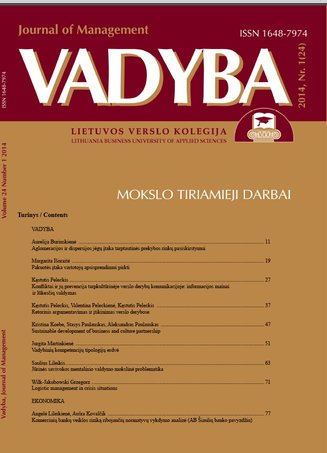TESTING THE STRATEGY OF WIDE DIVERSIFICATION INVESTMENT
PLAČIOS DIVERSIFIKACIJOS INVESTAVIMO STRATEGIJOS TESTAVIMAS
Author(s): Diana Cibulskienė, Martynas BrazauskasSubject(s): Economy
Published by: Lietuvos verslo kolegija
Keywords: Diversification; exchange traded fund - ETF; investment portfolio; Markowitz theory; risk.
Summary/Abstract: The capital market development and globalization determine the closer relationship among the different financial sectors in a country. Many scientists (Driessen ir Laeven, 2007, Mohamad, Hassan, Sori, 2006, Hui, 2005) determined that investment in the different countries helps reduce the risk, compared with investment in the different sectors in one country. Portfolio theory of risk reduction is often associated with investment diversification. Even in 1952 H. Markowitz emphasized the benefits of diversification by offering an investment portfolio split into a number of assets in order to spread the risk without reducing return. But in 2008 financial crisis spread globally, so even diversified portfolio did not protect against significant loss. This paper deals with the formation of widely diversified portfolios and their effectiveness evaluation after carrying out the possibility analysis of asset involvement into the widely diversified portfolio. Variety of investment means makes it easier and faster to invest in such classes of asset as goods, precious metals, real estate, as well as to take advantage of currency fluctuations. Research survey showed that the combination of different asset classes reduces the volatility of the portfolio at an inopportune time. The testing of investment portfolios showed that the results of actual investment portfolio do not reflect the expected results. For a variety of market factors the optimal investment portfolio did not increase returns or reduce risk. Widely diversified (risk-taking and risk-free) investment portfolio value decreased because of the Japanese yen and precious metals ETF values decline. The risk of risk-free diversified investment portfolio is the lowest of all the form of investment portfolios, but the average return is negative. The diversification benefit reflects only in widely diversified, risk-free and base investment portfolios, then the portfolio risk is the lowest, but the average return is close to zero. The comparison of broadly diversified and stock ETF investment portfolios showed that widely split investments can reduce market risk. As the analysis showed, past results do not reflect future results and could result the loss, therefore it is recommended to overlook even the widely diversified investment portfolio composition.
Journal: VADYBA
- Issue Year: 24/2014
- Issue No: 1
- Page Range: 97-103
- Page Count: 7
- Language: Lithuanian

